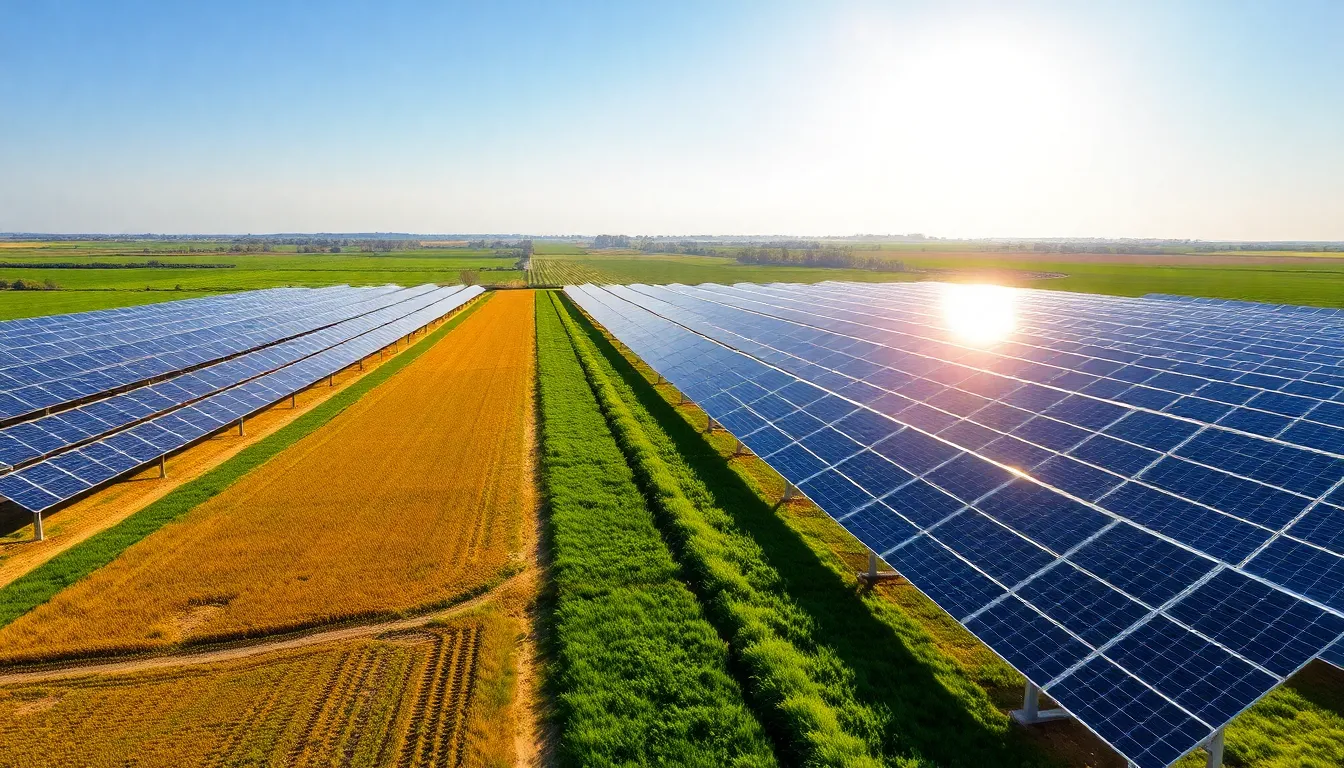As the world shifts towards sustainable energy, solar power projects are leading the charge. Harnessing the sun’s abundant energy, these initiatives not only reduce carbon footprints but also promise significant economic benefits. From small-scale residential installations to expansive solar farms, the versatility of solar technology is reshaping how communities generate and consume electricity.
Investors and innovators are increasingly drawn to solar energy’s potential, making it a focal point in the global energy transition. With advancements in technology and decreasing costs, solar power is more accessible than ever. This article explores the latest trends, successful projects, and the impact of solar energy on both local and global scales, highlighting why it’s a vital component of a sustainable future.
Table of Contents
ToggleOverview of Solar Power Projects
Solar power projects encompass a variety of installations that harness sunlight for energy generation. These projects include small-scale residential systems, commercial installations, and large utility-scale solar farms. They play a crucial role in reducing dependence on fossil fuels and lowering greenhouse gas emissions.
Solar power projects can be categorized into three main types:
- Photovoltaic (PV) Systems: PV systems convert sunlight directly into electricity using solar panels. They can be roof-mounted or ground-mounted, making them versatile for different settings.
- Concentrated Solar Power (CSP): CSP projects use mirrors or lenses to concentrate sunlight onto a small area, generating heat that drives a turbine to produce electricity. This technology is more common in large-scale applications.
- Hybrid Systems: Hybrid systems combine solar power with other energy sources, such as wind or natural gas. These systems enhance reliability and provide continuous energy supply, even during low sunlight conditions.
The economic impact of solar power projects is significant. The Solar Energy Industries Association (SEIA) reports that the U.S. solar industry employed over 250,000 individuals in 2021, contributing to job creation in various sectors, including manufacturing, installation, and maintenance.
Investment in solar power projects continues to grow due to decreasing costs and increasing efficiency. According to Lazard’s Levelized Cost of Energy Analysis, the cost of solar energy has dropped by approximately 88% since 2009, making it one of the most affordable renewable energy sources today.
Communities adopting solar power projects experience benefits like reduced energy bills and energy independence. Local governments often support these initiatives through incentives and financing options, promoting broader adoption and investment.
Overall, solar power projects represent a transformative approach to energy generation, aligning with global efforts to combat climate change and promote sustainability.
Benefits of Solar Power Projects

Solar power projects offer numerous advantages that benefit both the environment and the economy. These projects promote sustainability and enhance energy independence for communities.
Environmental Impact
Solar power projects significantly reduce greenhouse gas emissions, lowering air pollution and combatting climate change. By transitioning to solar energy, communities decrease their reliance on fossil fuels, contributing to a healthier ecosystem. The use of solar energy leads to a reduction of around 90% in carbon dioxide emissions compared to traditional energy sources. Additionally, solar installations require minimal water usage, making them viable in arid regions. Solar farms can coexist with agricultural land, allowing for dual land use that supports biodiversity.
Economic Advantages
Economic benefits from solar power projects are substantial. The U.S. solar industry employed over 250,000 individuals in 2021, providing jobs in installation, maintenance, and manufacturing. Investment in solar technology has surged, reflecting a 20% annual growth rate in the sector. The average cost of solar energy has decreased by about 88% since 2009, making solar installations more accessible for homeowners and businesses. Communities experience lower energy bills, with savings up to 30% compared to traditional power sources. Local governments often incentivize solar adoption through tax credits and rebates, further enhancing the financial appeal.
Key Components of Solar Power Projects
Solar power projects consist of essential components that ensure efficient energy generation. Understanding these components is crucial for maximizing the effectiveness of solar installations.
Solar Panels
Solar panels, or photovoltaic (PV) modules, convert sunlight into electricity through the photovoltaic effect. Common types of solar panels include monocrystalline, polycrystalline, and thin-film, each offering different efficiency rates and costs. Monocrystalline panels generally provide the highest efficiency at around 15-22%, while polycrystalline panels typically range from 13-16%. Thin-film panels, while less efficient at approximately 10-12%, are lightweight and flexible, making them suitable for specific applications. The choice of solar panels significantly impacts overall system performance and return on investment.
Inverters
Inverters play a critical role in solar power projects by converting direct current (DC) generated by solar panels into alternating current (AC) used by home appliances and the electrical grid. Two primary types of inverters exist: string inverters and microinverters. String inverters connect multiple panels together and are cost-effective for larger installations, while microinverters attach to individual panels, offering better performance in shaded conditions. Choosing the appropriate type of inverter enhances energy efficiency and ensures optimal energy production.
Mounting Systems
Mounting systems are essential for securely installing solar panels on various surfaces like rooftops or the ground. Key types of mounting systems include fixed rooftop mounts, ground-mounted systems, and tracking systems. Fixed mounts are the most common, providing stability at a specific angle. Ground-mounted systems offer flexibility in positioning for optimal sun exposure. Tracking systems adjust the panel’s angle throughout the day to follow the sun’s path, increasing energy capture by 20-30%. Selecting the right mounting system affects installation ease, system longevity, and energy efficiency.
Case Studies of Successful Solar Power Projects
Numerous solar power projects have exemplified the effectiveness and viability of solar energy. Examining successful initiatives in California and Germany reveals significant advancements and impactful outcomes.
Project in California
California’s Solar Initiative has led to the installation of over 1 million solar systems since its inception. The state boasts the largest solar power capacity in the U.S., with a total installed capacity exceeding 40,000 megawatts (MW). A notable project, the Mount Signal Solar Farm, spans 2,000 acres and generates approximately 300 MW of electricity. Projects like this have contributed to powering nearly 90,000 homes and reducing carbon emissions by nearly 200,000 metric tons annually. California’s commitment to renewable energy, supported by government incentives and policies, solidifies its leadership in the solar sector.
Project in Germany
Germany plays a pivotal role in advancing solar technology and policies. The country initiated the Feed-in Tariff program in 2000, promoting renewable energy generation. As of 2022, Germany’s solar capacity reached around 60,000 MW, positioning it as a top solar producer worldwide. The Solarfeld project in Baden-Württemberg, featuring over 1,500 solar panels, has optimized land use while generating significant power. This project alone supplies electricity to approximately 1,500 homes and reduces carbon emissions by an estimated 3,500 tons each year. Germany’s approach illustrates the effectiveness of supportive policies in accelerating solar energy adoption.
Challenges Facing Solar Power Projects
Solar power projects encounter several challenges that can hinder their growth and effectiveness. Addressing these issues is vital for maximizing the potential of solar energy in promoting sustainability.
Regulatory Hurdles
Regulatory hurdles often pose significant barriers to solar power projects. Inconsistent policies across states can complicate project approval processes. Local zoning laws may restrict land use for solar installations, diminishing potential sites for solar farms. Permitting procedures can be lengthy and vary by jurisdiction, impacting timelines. Additionally, interconnection standards, which dictate how solar systems connect to the grid, may lack uniformity. Navigating these complex regulations demands considerable resources, deterring some investors from pursuing solar initiatives.
Technological Limitations
Technological limitations present additional challenges for solar power projects. Current solar panel efficiency rates average around 15-22%, which affects energy output. Energy storage solutions, essential for managing intermittent sunlight, often rely on lithium-ion batteries that, while effective, may be costly and face supply chain issues. The need for land space for large solar farms can lead to competition with agricultural or natural landscapes, limiting available locations. Furthermore, innovations like advanced photovoltaic materials and better energy conversion techniques are still in development stages, with commercial viability remaining uncertain. These technological barriers impact project feasibility and cost-effectiveness, affecting overall adoption rates in the energy market.
Future Trends in Solar Power Projects
Technological advances in solar power continue to shape the future landscape of energy generation. Innovations such as bifacial solar panels, which capture sunlight from both sides, enhance energy output. Energy storage solutions, like lithium-ion batteries, are becoming more efficient, allowing for better energy management. Smart grid technologies enable more effective integration of solar energy into existing infrastructures, optimizing usage.
Government policies will increasingly focus on incentivizing renewable energy investments. Incentives like feed-in tariffs and tax credits promote solar adoption, encouraging both residential and commercial installations. With global commitments to reduce carbon emissions, regulations are likely to evolve, fostering a supportive environment for solar power advancements.
By improving infrastructure, solar power projects can achieve higher efficiency levels. Developing better energy transmission systems minimizes losses during electricity distribution. Moreover, integrating solar technologies with electric vehicle (EV) charging stations enhances the appeal of solar energy for eco-conscious consumers.
Collaborations among stakeholders will drive solar project viability. Investors, technological innovators, and policymakers will work together to create sustainable financing models. These partnerships can accelerate the deployment of solar projects, especially in underserved areas that benefit from renewable energy access.
Public awareness of climate change will heighten interest in renewable energy options. Communities are increasingly recognizing the importance of energy independence and sustainability. Education programs and community outreach initiatives can foster a stronger support base for local solar projects.
In anticipating the future, global solar capacity is projected to reach approximately 5,000 gigawatts (GW) by 2025, marking a significant increase from previous years. Countries leading the charge, such as China and the United States, will continue to invest heavily in solar infrastructure, boosting their economies and reducing carbon footprints.
Overall, trends in solar power projects indicate robust growth and innovation. Emphasizing efficiency, collaboration, and community engagement will drive the expansion of solar energy as a critical component of the global energy transition.
Solar power projects are paving the way for a sustainable energy future by offering environmental and economic benefits. As communities embrace these initiatives, they’re not only reducing their carbon footprints but also creating jobs and fostering energy independence.
The ongoing advancements in technology and supportive policies are critical for overcoming challenges and maximizing the potential of solar energy. With a growing focus on innovation and collaboration, the solar sector is poised for significant growth.
As public awareness of climate change rises, the momentum behind solar power projects is likely to accelerate, making them a cornerstone of the global energy transition. Embracing solar energy is not just a choice; it’s a necessity for a healthier planet and a sustainable economy.









